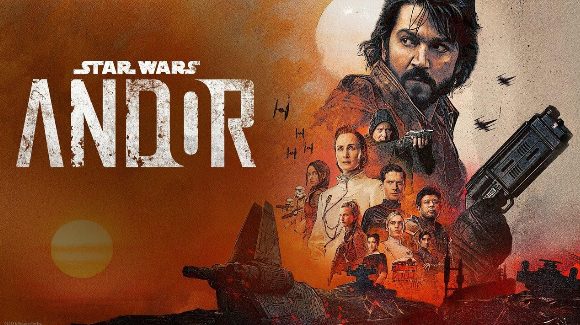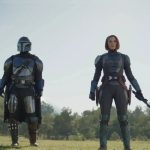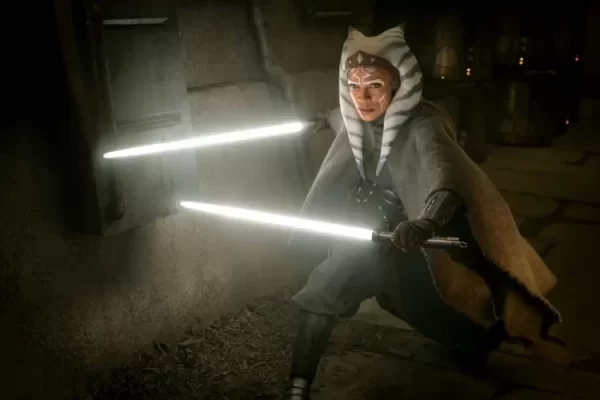The backstory (of me):
So, I’m a bit late to the party.
I used to pride myself on being perfectly up-to-date on every Star Wars movie. I was in the theaters right on the release day for the sequel trilogy, Rogue One, and Solo. I didn’t watch The Clone Wars or Rebels until I turned 18, but I was quick to catch up with every TV show I’d missed out on. And, by the time the Obi-Wan Kenobi show was coming out in May 2022, I was following along.
But another important event happened that May – I graduated from college. And, as I moved home and began my job search, I couldn’t bring myself to unwind and relax with Star Wars content.
It was around August that I finally finished Obi-Wan Kenboi – and over seven months before I started watching Andor on the night before my birthday. From there, I sporadically completed all twelve episodes in roughly a month’s time.
There’s just something so comforting about watching a brand new Star Wars episode when you’re curled up in your pajamas. It feels especially intimate. And it made me wonder why I’d waited so long to dive into Andor.
The backstory (of the show):
I saw Rogue One twice in theaters. To date, I’ve seen it seven times total. It’s one of my favorite Star Wars movies, and (in my opinion) the best out of the entire new lineup. It creates fantastic, sympathetic, and compelling characters in just over two hours – and it breaks your heart like you never expected.
Andor was a fascinating announcement. This was a show set to be focused on a single character from Rogue One, taking place five years before the events of the movie. But, more interesting than that, it would be twelve episodes.
Before Andor, there had been three other live-action Star Wars TV shows. They were The Mandalorian, The Book of Boba Fett, and Obi-Wan Kenobi. Respectively, these shows each had eight, seven, and six episodes per season. Out of all three, The Mandalorian was the only one to become more than a miniseries. (And no complaints here – The Book of Boba Fett and Obi-Wan Kenobi functioned perfectly with the lengths they were given.)
Giving Andor twelve episodes would give the show more screen time than any of these. It would allow space for a large cast of characters, extended plot points, and a fleshed-out storyline and arc for Cassian Andor himself. So did the show fulfill these promises?
Entering the rebellion
Oh, absolutely.
Andor begins with the titular character making a terrible, impulsive mistake and finding himself on the run from the Empire. As he attempts only to save his own life, his struggle leads him to the center of a growing rebellion and the possibility of his own place within it.
I loved the pace of this show. My favorite episodes were 3, 7, 9, and 10, but I can’t name one I didn’t enjoy. The plot is just as layered and multi-faceted as I’d hoped, and the writing is sublime. There’s very little over-explaining or unnecessary exposition. Andor does what I always appreciate and doesn’t treat the audience like they weren’t paying attention – no repeated statements or heavy-handed monologues.
The characters are just as vast. From the overly-ambitious Imperial agent to the woman rising in rank to the band of rebels working with Luthen Rael, we’re treated to a fascinating array of arcs and motivations. I especially liked Cassian’s adoptive parents, his best friend, and his ex-girlfriend, who gave us so much story all on their own.
The rebel group led by Vel was an interesting one. I enjoyed learning the individual backstories and driving forces of everyone involved (and Nemik’s writing, my heart) including the lead up to discovering who Vel truly was. And alongside these newcomers, we’re also reintroduced to familiar faces, such as Mon Mothma and Saw Gerrera, who fit perfectly in the timeline.
(Doing the math, I decided that Jyn theoretically could have been in the show – although I get why she wasn’t; this is Cassian’s time. But if Jyn was 21 in R1, Andor takes place five years before R1, and Saw abandoned Jyn when she was 16… technically, she could still be with Saw at this point, right?)
Originally, much as I loved Rogue One, I was curious if Cassian was the one most benefited by his own show. We didn’t learn much about him in the movie, but his painful line to Jyn about how he’s “been in this fight since he was six years old” shaped a hazy image of his past. In a way, I liked only having that snippet of Cassian and the theories it formed.
Technically, Andor undoes that line a bit – or, more accurately, reshapes Cassian’s claim into one more dramatic. Cassian doesn’t look six in the flashback scenes, but it seems as if the Empire harmed his planet (possibly killing the adults) in the past. With this in mind and with Cassian ultimately becoming a devoted agent to the Rebellion, his line to Jyn reforms his entire past. In retrospect, Cassian sees that day in his childhood as the beginning of his path to rebellion – he just took a little longer to get there.
What I was pleasantly surprised by was the lack of over-the-top Rogue One references. I was wary that the show would lean too heavily on its origin movie, such as giving Cassian lines about how he doesn’t think any cause is worth dying for and the like. But nothing is so unsubtle as to distract you from the storyline of Andor. From episode to episode, it’s easy to get so wrapped up in the show that you forget about where all of this is going to eventually lead Cassian. The only direct Rogue One tie-in comes near the end of episode 7, where Cassian encounters a KX-series security droid (aka the same make and model as our good friend K-2SO). It’s very nicely timed, taking place around the midpoint of the show. For me, it served as a sharp reminder of the events of Rogue One – in that moment, I was thrown back into the heartbreaking ending of the movie.
As with any good Star Wars show, we’re treated to references to the greater universe. Some of them are direct, such as the appearance of Admiral Yularen in episodes 7 and 8. Some are more subtle, such as the background appearance of a white and gold Temple Guard mask in Luthen’s shop. And there are many other subtle inclusions to remind you that we’re in a galaxy far, far away, such as the multi-horned goats (officially called dray) we meet in episode 4.
Ultimately, Andor’s greatest strength comes from how it delivers the ever-present themes of Rogue One so beautifully. Family, friendship, war, death, heroism, moral compromising, and the sacrifices made for a future you’ll never see yourself. (Looking at you, episode 10!)
Paving the way
Initially, I was disappointed by the last episode. I thought that Andor would only be one season, and the finale left me with more questions than answers. But no, we’ll be receiving a second and final season, one set to end in the days leading up to Rogue One. So, we’ll surely be getting more R1 references – and hopefully we’ll finally meet K2!
A common complaint brought up among Star Wars fans is the franchise’s clinging attachment to the Skywalker bloodline. In such a wide galaxy with centuries of history and millions of planets, every story seems to tie back into the lineage of Shmi Skywalker. A less frequent critique, though equally frustrated, is the need for every piece of Star Wars media to be linked to the Jedi. While this makes sense in the Republic Era, the complaint can tend to lose water when the plot narrows in on the Rebellion. After all, the Jedi were a centralizing force in the galaxy before Palpatine’s takeover and instrumental in the ultimate battle. But a story like Andor focusing on the regular people banding and working together for the betterment of the galaxy? Now that’s a good show.
I’m both looking forward to and dreading the final season of Andor. This time, I’ll be sure to get to it as it comes out – this show is all my R1 loving heart could’ve dreamt of!



